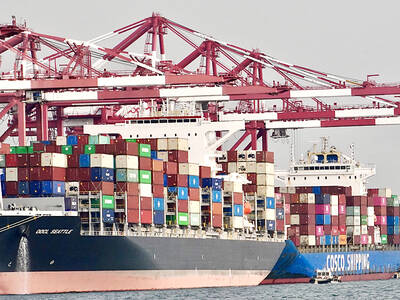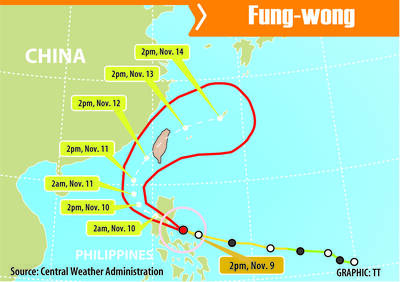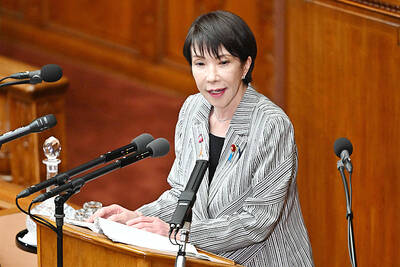After three consecutive quarters of decline, the economy rebounded in the second quarter with year-on-year growth of 0.69 percent, supported by better-than-expected exports, the Directorate-General of Budget, Accounting and Statistics (DGBAS) said yesterday.
The 0.69 percent growth was higher than the 0.48 percent growth the DGBAS forecast in May.
“By the latest data, we could say that the economy is stabilizing slowly. Some local industries showed a positive outlook, such as the electronic components industry,” DGBAS section head Wang Shu-chuan (王淑娟) told a news conference.

Photo: Cheng Chi-fang, Taipei Times
Exports of electronic goods increased by 1.9 percent year-on-year in the second quarter, ending four quarters of contraction, thanks to a recovery in the semiconductor industry, the statistics agency said in a statement.
A sharp decline in the number of Chinese tourist in the second quarter had no obvious impact on the economy as tourists from other nations, such as Japan and South Korea, filled the gap, Wang said.
After price adjustments, real exports, including exported services and goods, increased by 0.65 percent in the second quarter, better than the agency’s 0.29 percent growth forecast, DGBAS data showed.
Private consumption in the second quarter rose 1.05 percent year-on-year, led by a 4.71 percent increase in new car purchases on the back of government subsidies.
However, capital formation — the net additions of equipment, buildings and other intermediate goods — declined 3.11 percent last quarter from the previous year, as the appreciation of the yen dragged down local capital formation, Wang said.
Nearly one-third of the nation’s machinery is imported from Japan, she added.
By sector, GDP growth in the second quarter was led by the output of financial and insurance companies, which climbed 1.6 percent from a year earlier, while manufacturing sector remained sluggish on muted demand with output falling 0.12 percent year-on-year, the smallest decline in five quarters, according to DGBAS.
The second quarter’s mild economic growth has not changed the agency’s full-year GDP estimate of 1.06 percent, Wang said.
In the first half of this year, GDP increased slightly by 0.01 percent from the previous year and the economy might remain weak in the second half due to various macroeconomic uncertainties including terrorist attacks, Brexit impacts and the rise of protectionism, Wang said.

The Central Weather Administration (CWA) yesterday said it expected to issue a sea warning for Typhoon Fung-Wong tomorrow, which it said would possibly make landfall near central Taiwan. As of 2am yesterday, Fung-Wong was about 1,760km southeast of Oluanpi (鵝鑾鼻), Taiwan’s southernmost point, moving west-northwest at 26kph. It is forecast to reach Luzon in the northern Philippines by tomorrow, the CWA said. After entering the South China Sea, Typhoon Fung-Wong is likely to turn northward toward Taiwan, CWA forecaster Chang Chun-yao (張峻堯) said, adding that it would likely make landfall near central Taiwan. The CWA expects to issue a land

Taiwan’s exports soared to an all-time high of US$61.8 billion last month, surging 49.7 percent from a year earlier, as the global frenzy for artificial intelligence (AI) applications and new consumer electronics powered shipments of high-tech goods, the Ministry of Finance said yesterday. It was the first time exports had exceeded the US$60 billion mark, fueled by the global boom in AI development that has significantly boosted Taiwanese companies across the international supply chain, Department of Statistics Director-General Beatrice Tsai (蔡美娜) told a media briefing. “There is a consensus among major AI players that the upcycle is still in its early stage,”

The Central Weather Administration (CWA) yesterday said it is expected to issue a sea warning for Typhoon Fung-wong this afternoon and a land warning tomorrow. As of 1pm, the storm was about 1,070km southeast of Oluanpi (鵝鑾鼻), Taiwan’s southernmost point, and was moving west-northwest at 28 to 32kph, according to CWA data. The storm had a radius of 250km, with maximum sustained winds of 173kph and gusts reaching 209kph, the CWA added. The storm is forecast to pass near Luzon in the Philippines before entering the South China Sea and potentially turning northward toward Taiwan, the CWA said. CWA forecaster Chang Chun-yao (張峻堯) said

Japanese Prime Minister Sanae Takaichi yesterday said that China using armed force against Taiwan could constitute a "survival-threatening situation" for Japan, allowing the country to mobilize the Japanese armed forces under its security laws. Takaichi made the remarks during a parliamentary session while responding to a question about whether a "Taiwan contingency" involving a Chinese naval blockade would qualify as a "survival-threatening situation" for Japan, according to a report by Japan’s Asahi Shimbun. "If warships are used and other armed actions are involved, I believe this could constitute a survival-threatening situation," Takaichi was quoted as saying in the report. Under Japan’s security legislation,